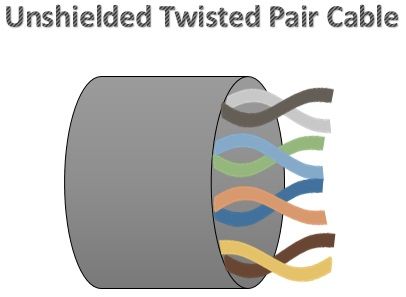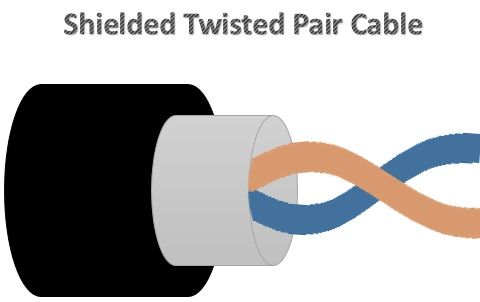 UTP (Unshielded twisted pair) and STP (Shielded twisted pair) are the types of twisted pair cables which act as a transmission medium and imparts reliable connectivity of electronic equipment. Although the design and manufacture are different but both serve the same purpose.
UTP (Unshielded twisted pair) and STP (Shielded twisted pair) are the types of twisted pair cables which act as a transmission medium and imparts reliable connectivity of electronic equipment. Although the design and manufacture are different but both serve the same purpose.
The basic difference between UTP and STP is UTP (Unshielded twisted pair) is a cable with wires that are twisted together to reduce noise and crosstalk. On the contrary, STP (Shielded twisted pair) is a twisted pair cable confined in foil or mesh shield that guards the cable against electromagnetic interference.
Content: UTP Cable Vs STP Cable
Comparison Chart
| Basis for comparison | UTP | STP |
|---|---|---|
| Basic | UTP (Unshielded twisted pair) is a cable with wires that are twisted together. | STP (Shielded twisted pair) is a twisted pair cable enclosed in foil or mesh shield. |
| Noise and crosstalk generation | High comparatively. | Less susceptible to noise and crosstalk. |
| Grounding cable | Not required | Necessarily required |
| Ease of handling | Easily installed as cables are smaller, lighter, and flexible. | Installation of cables is difficult comparatively. |
| Cost | Cheaper and does not require much maintenance. | Moderately expensive. |
| Data Rates | Slow comparatively. | Provides high data rates |
Definition of UTP Cable
Unshielded twisted-pair (UTP) cable is the most prevalent type of telecommunication medium in use today. Its frequency range is suitable for transmitting both data and voice. Therefore, these are most commonly used in telephone systems.
A twisted pair consists of two insulated conductors (usually copper) in a twisted configuration. Color bands are used in plastic insulation for identification. In addition, colors also identify the specific conductors in a cable and to indicate which wires belong in pairs and how they relate to other pairs in a larger bundle.
 The two wires are twisted in the twisted pair cable which significantly reduces the noise generated by the external source. The noise here we are talking about is generated when two wires are parallel which causes an increase in voltage level in the wire closest to the source and also uneven load and damaged signal.
The two wires are twisted in the twisted pair cable which significantly reduces the noise generated by the external source. The noise here we are talking about is generated when two wires are parallel which causes an increase in voltage level in the wire closest to the source and also uneven load and damaged signal.
Definition of STP Cable
Shielded twisted-pair (STP) cable has an additional braided mesh coating or metal foil that wraps each set of insulated conductors. The metal casing intercepts the penetration of electromagnetic noise. It also can eradicate a phenomenon called crosstalk, which is the unwanted effect of one circuit (or channel) on another circuit (or channel).
 It occurs when one line (acting as a kind of receiving antenna) picks up some of the signals travelling down another line (acting as a kind of sending antenna). This effect can be experienced during telephone conversations when one can hear other conversations in the background. Shielding each pair of a twisted-pair cable can eliminate most crosstalk.
It occurs when one line (acting as a kind of receiving antenna) picks up some of the signals travelling down another line (acting as a kind of sending antenna). This effect can be experienced during telephone conversations when one can hear other conversations in the background. Shielding each pair of a twisted-pair cable can eliminate most crosstalk.
STP has the similar quality factor and uses the same connectors as UTP, but the shield must be connected to the ground.
Key Differences Between UTP and STP Cables
- UTP and STP are the types of twisted pair cable where UTP is the unshielded type whereas STP is shielded, for doing so metal foil or braided mesh is used.
- UTP reduces the crosstalk and noise as compared to the parallel arrangement of the wires but not at great extent. On the contrary, STP decreases the crosstalk, noise, and electromagnetic interference significantly.
- UTP cables are easily installed while installation of STP cables is difficult are the cables are bigger, heavier and stiffer.
- Grounding is not required in UTP cables. As against, STP cables requires grounding.
- UTP cables are inexpensive whereas STP cables are costly comparatively due to additional material and manufacturing.
- STP cables incorporate a conducting shield built of metallic foil enclosing the twisted wire pairs, which obstructs out electromagnetic interference, permitting it to carry data at an enhanced rate of speed. In contrast, UTP provides less speed of data transfer.
Conclusion
UTP and STP cables differ in the design and structure where STP cable has an additional metal foil wrapped in insulated conductors.
However, both STP and UTP cables have their respective merits and demerits, when it comes to proper installation and maintenance in a suitable situation for their use, both work finely.
Shubham Goyal says
A very Informative Blog, I was in dilemma between the two products as they sound much of similar to me but now i am very much clear between their differences. Thanks for sharing the article.
pritam iklodiya says
Clear interpretation
Joel says
Thanks for the blog, It gives me a clear understanding of the difference between UTP and STP.
Very helpful
hitesh says
Really Nice one
hitesh says
Really Helpful
R Eswar sai says
Really awesome..
G.Nagarajan says
My doubts are cleared
Jagathesan.K says
Thanks for the information. It was Really helpful.
Martha says
Thanks,this helps a lot.How can I subscribe to this website?
Saber kamal says
Thank you for ur information
It’s helpful